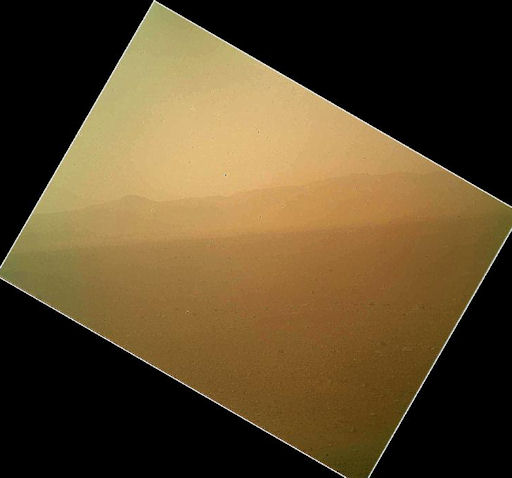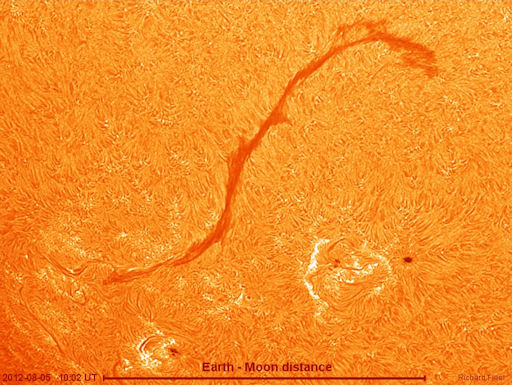CHANCE OF STORMS: NOAA forecasters estimate a 25% chance of polar geomagnetic storms on August 7/8. That's when a coronal mass ejection (CME) hurled into space by a filament eruption on Aug. 4 could deliver a glancing blow to Earth's magnetic field. Aurora alerts: text, voice.
FIRST COLOR IMAGE FROM CURIOSITY: Curiosity's first color image of Mars has just been beamed back to Earth--and it's a little dusty. This murky view of the landscape to the north of the rover was captured by the Mars Hand Lens Imager (MAHLI) on the afternoon of the first day after landing:
The image shows the north wall and rim of Gale Crater. The view is murky because MAHLI's removable dust cover is apparently coated with dust blown onto the camera during the rover's terminal descent. Another camera, the Descent Imager, photographed the roughly circular swirls of dust kicked up from the Martian surface by the rocket motor exhaust.
The MAHLI camera is located on the turret at the end of Curiosity's robotic arm. The camera's main purpose is to acquire close-up, high-resolution views of rocks and soil at the rover's Gale Crater field site. MAHLI is capable of focusing on any target at distances of about 0.8 inch (2.1 centimeters) to infinity. This means it can take not only close-up pictures of rocks but also big-picture images of the landscape as shown above.
In a week or so, MAHLI's dust cover will come off and the view will improve. Stay tuned for more images.
SUN SERPENT: Amateur astronomers arpund the world are monitoring a gigantic filament of magnetism on the sun. If one end of the filament were on Earth, the other end would reach all the way to the Moon. The dimensions of the structure make it an easy target for amateur solar
telescopes. Richard Fleet sends this picture from his backyard observatory in Wiltshire, England:
This filament is filled with billions of tons of plasma, yet it has remained suspended above the surface of the sun for days. Such a massive structure, buffeted as it is by winds and currents in the sun's atmosphere, is unlikely to remain stable much longer. If the filament collapses, it could crash into the surface of the sun and spark a powerful type of explosion called a Hyder flare. Amateur astronomers are encouraged to monitor developments.

![]()
Solar wind
speed: 404.2 km/sec
density: 1.8 protons/cm3
explanation | more data
Updated: Today at 1626 UT
![]()
X-ray Solar Flares
6-hr max: C4 1330 UT Aug07
24-hr: C4 1330 UT Aug07
explanation | more data
Updated: Today at: 1600 UT
![]()
![]()
![]()
Daily Sun: 07 Aug 12
![]()
![]()
A new sunspot is emerging at the circled location. Credit: SDO/HMI
![]()
![]()
![]()
Sunspot number: 108
What is the sunspot number?
Updated 07 Aug 2012
Spotless Days
Current Stretch: 0 days
2012 total: 0 days (0%)
2011 total: 2 days (<1%)
2010 total: 51 days (14%)
2009 total: 260 days (71%)
Since 2004: 821 days
Typical Solar Min: 486 days
Updated 07 Aug 2012
The Radio Sun
10.7 cm flux: 134 sfu
explanation | more data
Updated 07 Aug 2012
![]()
![]()
![]()
Current Auroral Oval:
![]()
Switch to: Europe, USA, New Zealand, Antarctica
Credit: NOAA/POES
![]()
![]()
![]()
Planetary K-index
Now: Kp= 2 quiet
24-hr max: Kp= 3 quiet
explanation | more data
![]()
Interplanetary Mag. Field
Btotal: 4.1 nT
Bz: 1.3 nT south
explanation | more data
Updated: Today at 1626 UT
![]()
![]()
![]()
Coronal Holes: 07 Aug 12
![]()
![]()
There are no large coronal holes on the Earthside of the sun. Credit: SDO/AIA.






